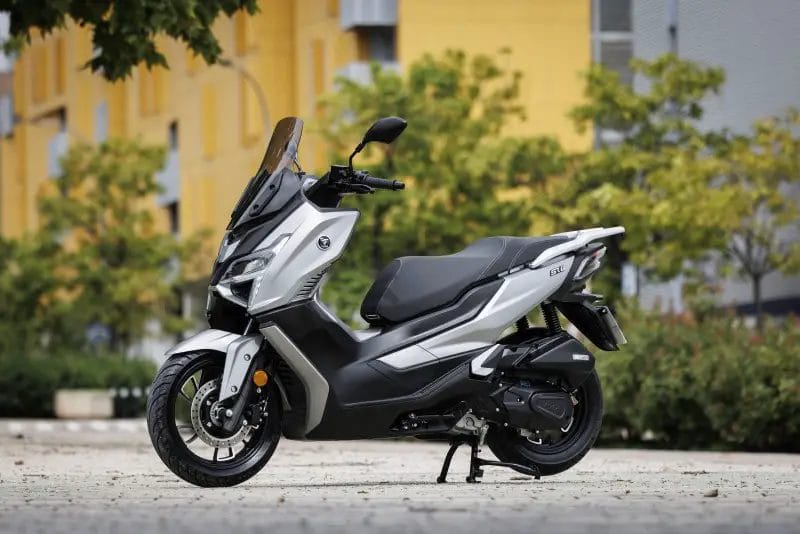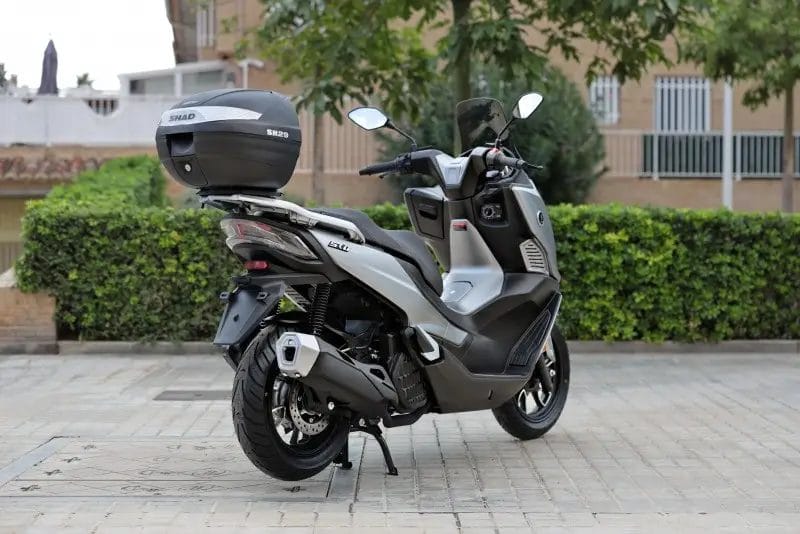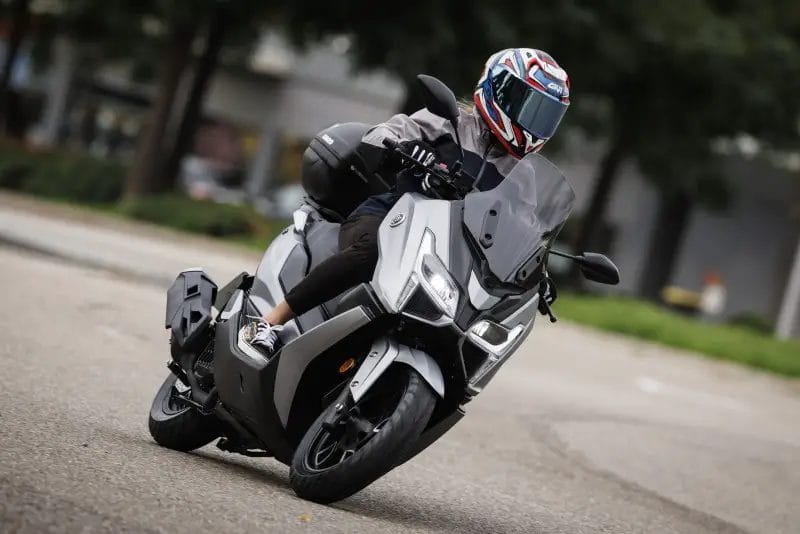After Voge’s debut in the 125 cc displacement with the 125R sports naked, which drew attention in the segment for its technology, design, performance and price, the Loncin group’s premium brand continues its expansion with the new SR1, a scooter with Italian design and Grand Touring style, adapted to everyday urban commuting, with more compact dimensions, very well equipped and powered by the new liquid-cooled engine that delivers 11.56 hp, with the safety of dual-channel ABS and TCS traction control, a high-definition video camera and a very attractive launch price.
2023 is the year of Voge’s expansion. After winning the hearts of the A2 public with its range of 300, 350, 500 and 650 cc motorcycles, as well as the SR4 Max scooter, the result of its collaboration with BMW, Voge is concentrating its efforts on the “eighth of a liter” displacement, in order to reach a group of A1 license holders (16-17 years old) and, above all, car license holders (B), who find 125 cc motorcycles and scooters the way to enter the world of motorized two wheels automatically.

A few months ago we witnessed Voge’s debut in this displacement with the 125R: a true sports naked, manufactured with the same care and finishes that Voge puts into its high displacement models, Italian design, with technology applied to its engine (DOHC, 4 valves, liquid cooling, Bosch injection, 6 speeds and 15 HP), good performance and a competitive price. That same formula that led to its success now applies to VOGE’s new launch, the SR1, the brand’s second scooter after the SR4 and the second in the 125 c displacement.
First and foremost, Voge wanted the SR1 to be an eye-catcher, and to this end it commissioned the Italian Massimo Zaniboni, who designed the 125R and SR4, and whose artistic genius has made almost all his creations for different brands bestsellers. For this SR1, Zaniboni has taken inspiration from the lines of sophisticated Grand Touring scooters, compacting its dimensions (1320 mm wheelbase) to make it more maneuverable for everyday urban commuting, without losing stability qualities on the outskirts of highways and freeways. In this regard, it’s worth highlighting its low seat-to-floor height of 775 mm, which will allow good accessibility for all statures and especially for women, who will appreciate its light weight of 139 kg. Not only does the 775 mm seat height allow both feet to rest on the ground for riders of any stature, but attention has also been paid to the riding position with a double ergonomic triangle (seat, handlebars, footrest platform) that allows for comfortable use, with a straight back when riding in the city, relaxing more when riding on the open road, stretching out the legs and resting the feet on the inclined and forward platforms. It also comes equipped with a center and side stand, the latter with power cut-off, and retractable rear footrests.


As far as lighting is concerned, Zaniboni’s attractive design is complemented by the LED technology applied to all its elements. The front headlamp is sporty in character, with its narrow and elongated double optics, complete with “L” shaped light guides on the outer and lower sides of the optics, which function as position lights; each optic includes two LED spotlights, with the dipped beam on the inside and the high beam on the outside. The front indicators, made up of rows of four diodes, are positioned vertically just below the headlight on the sides, leaving space between them for a pair of triangular air intakes that add to its aggressive sportiness. Above the headlight is a transparent windshield that helps protect the driver from the movement of air on the move, the cold and the rain.
The rear optical group also displays its own distinctive light signature full of freshness. The position lamp is based on a “T”-shaped light guide, with the brake light distributed more intensely on either side of the vertical “T” line and closing the set using the “L” for the indicators. A good detail that contributes to increasing the active safety of this scooter is the ESS system, which debuted on the SR4 scooter and consists of flashing the stop lights with high frequency in the event of sudden emergency braking, to warn vehicles following the SR1 of the dangerous situation.

The bike’s handling has also been thoroughly developed, with a frame that has been optimized in terms of rigidity and composure, accompanied by a set of suspensions in which the most modern technologies, previously applied in the development of the SR4 Max scooter, have been adopted to achieve maximum comfort for rider and passenger, while maintaining the scooter’s firmness when describing corners. The fork has 31 mm diameter sheaths and a stroke of 93 mm, while the pair of shock absorbers used includes a double pass spring and adjustable preload, providing a stroke of 103 mm. All this is accompanied by the choice of “medium wheel” tires in 14 and 13 inch diameters, with wide low profile sections: 110/70 and 130/70, respectively. Accompanying both wheels are 240 and 220 mm disc brakes for the front and rear axles, with their corresponding floating calipers and double and single pistons. The braking system includes an independent dual-channel ABS modulator and, completing the electronic safety equipment, a TCS traction control system that prevents the rear wheel from losing traction on low-grip surfaces, both when starting off and when cornering, by acting on the engine’s torque delivery.
The mechanics of the SR1 have undergone extensive development, with long dynamic tests in which the prototypes each ran for more than 60,000 km, as well as durability tests on the engine test bench for more than 200 uninterrupted hours to demonstrate the product’s total robustness, reliability and long service life. Likewise, the frame and seat, whose seams are waterproof, have been subjected to stress tests of 150,000 cycles.


The new powertrain features liquid cooling (radiator next to the right side of the engine), a head with balancers fitted with bearings to minimize friction and a variator transmission with a double-sided toothed belt, which delivers a maximum power (measured in the homologation laboratory) of 8.5 kW (11.56 CV) at 8,500 rpm and a torque of 11 Nm at 6,500 rpm. This new engine is also distinguished by its non-existent vibration level, noise levels below the homologation directives and low average consumption of 2.2 liters per 100 km, which translates into a range of more than 360 km.
As a daily transportation tool, the Voge SR1 responds with functional equipment. The volume under the seat is 29 liters, enough to house a full-face helmet without any problems, leaving space behind it to carry other small objects. This main cargo compartment is complemented by a glove compartment in the upper left part of the back, where you can charge your cell phone on the go using the USB socket.


Starting the car doesn’t require searching for the mechanical key in your pockets or backpack, as it has a proximity-based Keyless smart key system. The same smart key incorporates a button that allows you to locate the vehicle within a radius of 30 meters, or lock it in the event of theft. Starting is done via a block that integrates the ignition and steering lock functions, next to which there are buttons for opening the seat and the fuel filler cap.
The instrumentation relies on a digital color display with negative characters (white on black). This is the same one it shares with its sister, the 125R sports naked, and therefore has a high information content. The obligatory speedometer with large digits is joined by a rev counter, graphic levels for temperature and petrol content, clock, average consumption, voltmeter and full/partial odometer, as well as a wide range of indicator lights. The instrument panel has a photoelectric sensor that automatically adapts the brightness of the screen according to the outside light.


The Voge SR1 comes pre-installed with a high-definition HD video camera (1080 pixels) with which you can immortalize your favourite routes on an SD card. The SR1 will be available in three colors: white, silver and grey.







